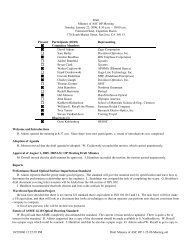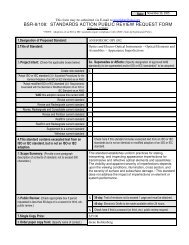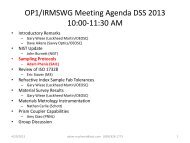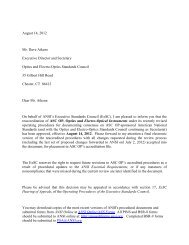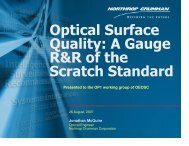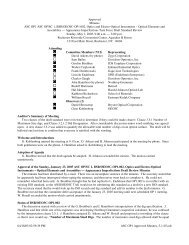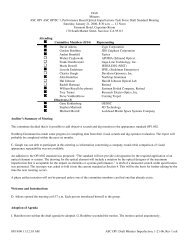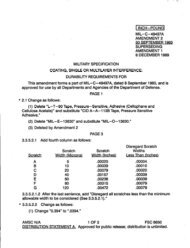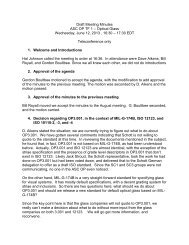INCH-POUND MIL-PRF-13830B 9 January 1997 SUPERSEDING ...
INCH-POUND MIL-PRF-13830B 9 January 1997 SUPERSEDING ...
INCH-POUND MIL-PRF-13830B 9 January 1997 SUPERSEDING ...
Create successful ePaper yourself
Turn your PDF publications into a flip-book with our unique Google optimized e-Paper software.
<strong>MIL</strong>-<strong>PRF</strong>-<strong>13830B</strong><br />
test additional samples as the inspector deems necessary.<br />
4.2.4.2 Test procedure. The cemented or bonded component shall be gradually<br />
heated in a dry atmosphere to plus 140 ± 2 degrees F, and then immediately placed in<br />
an ambient atmosphere of plus 130 ± 2 degrees F. at 95 percent relative humidity for<br />
2 hours. The optical assemblies shall be removed from the humid atmosphere,<br />
immediately wiped dry, and allowed to cool to room temperature. After 8 hours at<br />
room temperature the component shall be subjected to the tests specified in 4.2.3.2<br />
and 4.2.3.3. The test as specified in this paragraph shall be repeated in the same<br />
identical procedure whenever passable optical assemblies having edge separation or<br />
cement blisters at the start of the test increase, or additional cement defects develop<br />
not in excess of that specified in 3.6. Components failing the initial test, or a change<br />
in any cement defects, or the development of additional cement defects after the retest<br />
shall be cause for rejection including all optical assemblies having passable cement<br />
defects from the corresponding lots offered for inspection. All components subjected<br />
to the humidity tests shall be recemented and recoated if required prior to acceptance.<br />
4.2.4.3 Rejection criteria. Failure of one component to pass the tests specified in<br />
4.2.4 shall be cause for the components to be treated in the same manner as specified<br />
in 4.2.3.4.<br />
4.2.5 Resolution test. Resolution test shall be standard and shall be performed<br />
using one of the resolving power charts, see Figure 1. Resolving power is a measure of<br />
the optical performance. The resolving power is the angular subtense (in seconds of<br />
arc) of a series of parallel bars that can just be resolved. Resolving power is measured<br />
by viewing charts containing parallel bars of appropriate equal spacings. An auxiliary<br />
telescope is used to obtain sufficient magnification. A resolving power chart shall<br />
consist of four sets of lines, all sets either entirely three or entirely four lines at 45<br />
degree steps (horizontal, vertical, and two at 45 degrees). The three line sets shall<br />
contain lines that are five times as long as they are wide. The four line sets shall<br />
contain lines that are seven times as long as they are wide. The widths of lines and<br />
spaces shall be equal. The lines may be either black on a white background, or white<br />
on a black background. There shall be an identifying numeral in the center of the<br />
four sets of lines. The contrast shall be 100:1 minimum. The chart of appropriate<br />
dimensions may be located in a collimator, or it may be viewed directly. In the latter<br />
case, the chart shall be at least 2 M 2 feet from the telescope objective, where M is the<br />
power of the telescope being tested. The angular subtense of a chart is measured in<br />
seconds and equals arc tangent 2W/X, where W is the width of a chart line and X is<br />
either collimator focal length or distance from chart to telescope under test. The<br />
telescope under test is aligned so the chart is in the center of the field. The auxiliary<br />
telescope is added and oriented to again center the chart. With the diopter scale of<br />
the auxiliary telescope at zero, the telescope under test shall be focused on the<br />
numeral in the resolving power target. In reading resolution, the auxiliary telescope<br />
may be focused plus or minus 1/8 diopter for each of the four meridians. All four<br />
17<br />
Source: http://www.assistdocs.com -- Downloaded: 2006-05-24T15:32Z<br />
Check the source to verify that this is the current version before use.



